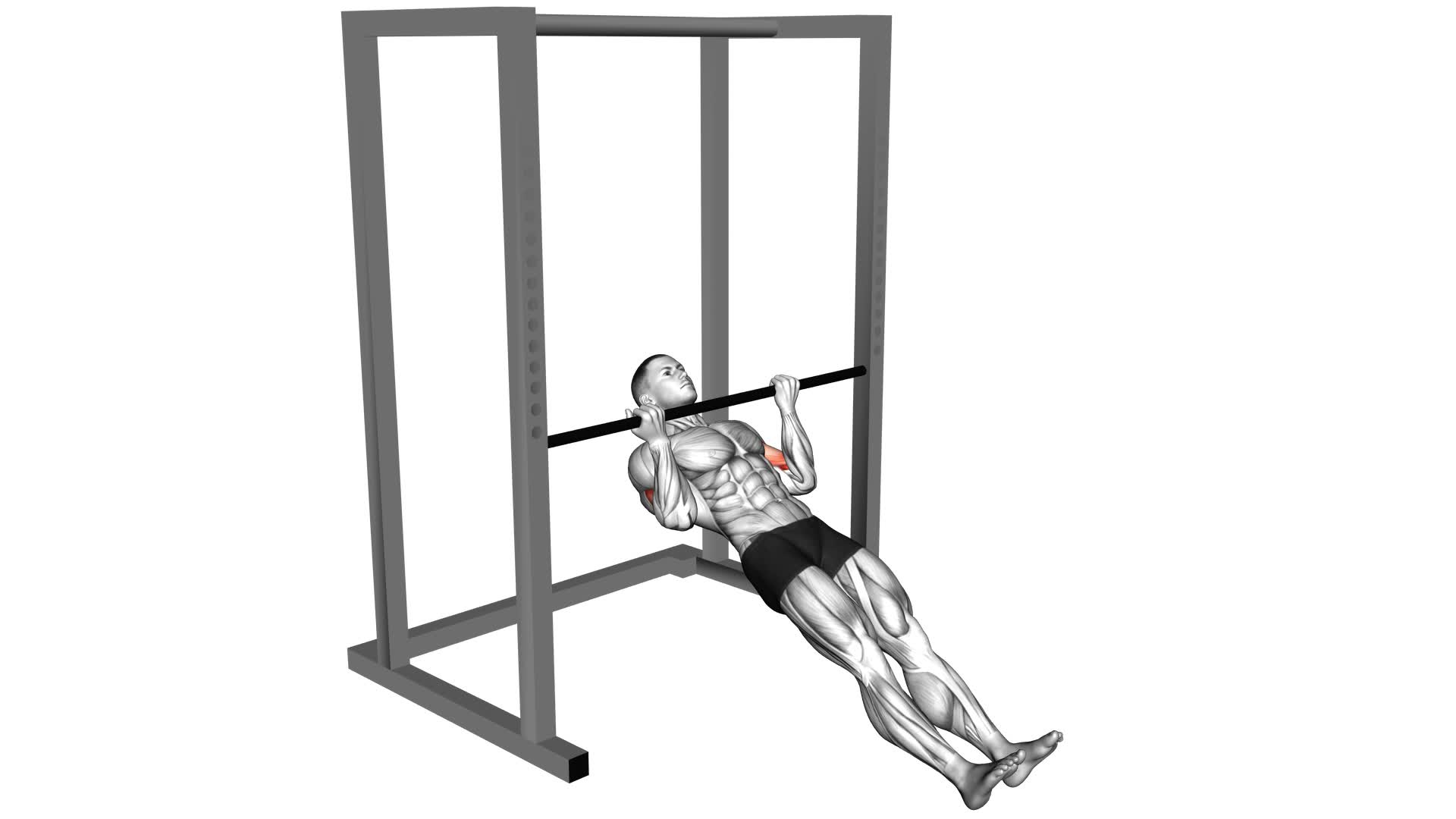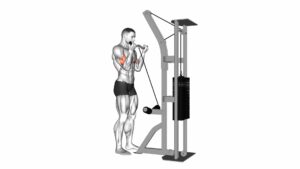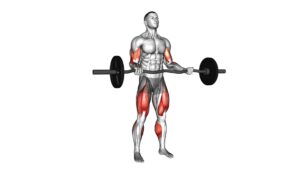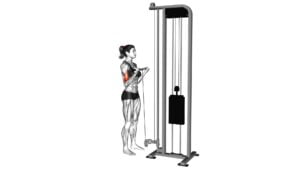Bar Biceps Curl – Video Exercise Guide & Tips

Looking to build bigger biceps?
Watch This Exercise Video
The bar biceps curl is a must-try exercise for you. In this video exercise guide, we'll show you the proper form and technique to maximize your gains. You'll also discover variations and progressions to keep challenging yourself.
Avoid common mistakes, increase bicep activation, and learn how to incorporate this exercise into your workout routine.
Get ready to pump up those biceps and achieve your fitness goals. Let's get started!
Key Takeaways
- Use appropriate weight for your fitness level
- Focus on contraction and control throughout the exercise
- Incorporate variations and progressions to increase intensity
- Squeeze the bar tightly to create tension and maximize bicep engagement
Proper Form and Technique
Use proper form and technique when performing the bar biceps curl to maximize your results and prevent injury. Building muscle requires a solid foundation, and using the proper equipment is essential.
When performing the bar biceps curl, make sure you have a barbell that's the appropriate weight for your fitness level. Start by standing with your feet shoulder-width apart and holding the barbell with an underhand grip, palms facing up. Keep your elbows close to your sides and your upper arms stationary throughout the exercise.
Slowly lift the barbell towards your shoulders, focusing on contracting your biceps. Avoid using momentum or swinging the weight up, as this can lead to injury and decrease the effectiveness of the exercise. Remember to exhale as you lift the weight and inhale as you lower it back down.
Aim for controlled and smooth movements, keeping your core engaged and your back straight. By using proper form and technique, you'll maximize your muscle-building potential and reduce the risk of injury.
Variations and Progressions
Try incorporating different variations and progressions into your bar biceps curl routine to challenge your muscles and continue making progress. By adding advanced techniques and exploring different equipment options, you can take your biceps curls to the next level.
Here are some ideas to keep your workouts fresh and effective:
- Advanced Techniques:
- Eccentric Curls: Slow down the lowering phase of the curl to increase time under tension and promote muscle growth.
- Preacher Curls: Use a preacher bench or an incline bench to isolate the biceps and focus on the contraction.
- Equipment Options:
- Dumbbells: Switching to dumbbells allows for a greater range of motion and activates additional stabilizer muscles.
- Resistance Bands: Incorporating resistance bands provides constant tension throughout the movement, challenging your muscles in a different way.
Remember to start with a weight that allows you to maintain proper form and gradually increase the intensity as you become more comfortable. By incorporating these variations and progressions into your routine, you'll keep your muscles guessing and continue to see results.
Common Mistakes to Avoid
To avoid hindering your progress and maximizing the effectiveness of your bar biceps curl routine, it's important to be aware of common mistakes to steer clear of.
By avoiding these mistakes, you can ensure that you're using proper technique and getting the most out of your workout.
One common mistake to avoid is using too much weight. While it may be tempting to load up the barbell with heavy plates, using too much weight can compromise your form and increase the risk of injury. Start with a weight that allows you to perform the exercise with proper form and gradually increase the weight as you get stronger.
Another mistake to avoid is using momentum to lift the barbell. It's important to focus on the contraction of your biceps and control the movement throughout the exercise. Using momentum not only reduces the effectiveness of the exercise, but it also increases the risk of injury.
It's also important to avoid swinging your body or arching your back during the bar biceps curl. These actions not only take the focus away from your biceps, but they also put unnecessary strain on your lower back. Keep your body stable and maintain proper posture throughout the exercise.
Tips for Increasing Bicep Activation
To further enhance the effectiveness of your bar biceps curl routine and maximize bicep activation, focus on maintaining a strong grip throughout the exercise. A strong grip allows for better engagement of the biceps muscles, leading to increased activation and improved results. Here are some tips to help you increase bicep activation during your bar biceps curl:
- Use an underhand grip: This grip places more emphasis on the biceps and helps to isolate the muscle group. It also allows for a greater range of motion, resulting in a more effective workout.
- Squeeze the bar tightly: By gripping the bar tightly, you create tension in the biceps, which increases activation. Focus on squeezing the bar throughout the entire movement to maximize bicep engagement.
Incorporating these bicep activation exercises and effective bicep training techniques will help you achieve better results from your bar biceps curl routine. By maintaining a strong grip and focusing on bicep activation, you can target the muscles more effectively and optimize your workout.
Now that you have learned how to increase bicep activation, let's move on to the next section, which will discuss how to incorporate the bar biceps curl into your workout routine.
How to Incorporate the Bar Biceps Curl Into Your Workout Routine
To incorporate the bar biceps curl into your workout routine, start by including it as a compound exercise for your upper body strength training. The bar biceps curl offers several benefits that make it a valuable addition to your routine.
Firstly, it targets the biceps muscles, helping to build strength and increase muscle mass in the arms. Additionally, it engages the forearms and stabilizer muscles, enhancing overall upper body strength and stability.
When comparing the bar biceps curl to dumbbell curls, there are a few key differences to consider. One advantage of the bar biceps curl is that it allows for a greater load to be lifted, as the weight is distributed evenly across both arms. This can lead to greater muscle activation and potential for muscle growth.
On the other hand, dumbbell curls offer a greater range of motion, allowing for more isolation and targeting of the biceps muscles. They also require more stabilization, engaging the core and other supporting muscles.
To incorporate the bar biceps curl effectively, consider adding it to your upper body workout routine 2-3 times per week. Start with a challenging weight that allows you to perform 8-12 reps with proper form. Gradually increase the weight as you get stronger. Remember to warm up thoroughly before starting your workout and always use proper form to prevent injury.
Frequently Asked Questions
What Are the Potential Benefits of Including Bar Biceps Curls in My Workout Routine?
Including bar biceps curls in your workout routine can have several potential benefits for your overall arm strength. These curls specifically target and engage your biceps muscles, helping to build size and definition.
Additionally, there are various variations of bar biceps curls, such as wide grip or close grip, which allow you to target different areas of your biceps.
Can Bar Biceps Curls Help Me Build Overall Arm Strength, or Do They Primarily Target the Biceps?
Bar biceps curls are a great exercise for building overall arm strength. While they primarily target the biceps, they also engage other muscles in the arms, such as the forearms and brachialis. If you're looking to strengthen your arms, bar biceps curls are a solid choice.
However, if you're looking for alternative biceps exercises, there are plenty of options available, such as dumbbell curls or hammer curls.
Is It Necessary to Use a Straight Barbell for Bar Biceps Curls, or Can I Use Dumbbells or an EZ Bar Instead?
You don't have to use a straight barbell for bar biceps curls. There are alternative equipment options like dumbbells or an EZ bar that you can use instead.
These alternatives can still effectively target your biceps and help you build overall arm strength. Dumbbells and an EZ bar offer variations in grip and movement, allowing you to work different angles of your biceps and keep your workouts diverse.
Are There Any Specific Warm-Up Exercises or Stretches I Should Do Before Performing Bar Biceps Curls?
Before performing bar biceps curls, it's important to do specific warm-up exercises and stretches. These help prepare your muscles for the workout and reduce the risk of injury.
You can start with some light cardio exercises like jogging or jumping jacks to get your blood flowing. Then, focus on stretching your biceps, forearms, and shoulders.
This will increase your flexibility and range of motion, allowing you to perform the bar biceps curls more effectively.
How Frequently Should I Incorporate Bar Biceps Curls Into My Workout Routine to See Noticeable Results?
To see noticeable results, it's important to consider the frequency of your bar biceps curls. Incorporating them into your workout routine two to three times a week is optimal.
This allows your muscles enough time to recover and adapt to the exercise, promoting growth and strength. Consistency is key, but remember to also vary your routine to avoid plateaus.
With the right frequency and effort, you'll start seeing those biceps gains in no time!
Conclusion
Incorporating the bar biceps curl into your workout routine can help increase bicep activation and improve overall strength in your arms.
By focusing on proper form and technique, avoiding common mistakes, and incorporating variations and progressions, you can maximize the benefits of this exercise.
Remember to consult with a fitness professional if you have any concerns or questions about incorporating the bar biceps curl into your workout routine.

Author
Years ago, the spark of my life’s passion ignited in my mind the moment I stepped into the local gym for the first time. The inaugural bead of perspiration, the initial endeavor, the very first surge of endorphins, and a sense of pride that washed over me post-workout marked the beginning of my deep-seated interest in strength sports, fitness, and sports nutrition. This very curiosity blossomed rapidly into a profound fascination, propelling me to earn a Master’s degree in Physical Education from the Academy of Physical Education in Krakow, followed by a Sports Manager diploma from the Jagiellonian University. My journey of growth led me to gain more specialized qualifications, such as being a certified personal trainer with a focus on sports dietetics, a lifeguard, and an instructor for wellness and corrective gymnastics. Theoretical knowledge paired seamlessly with practical experience, reinforcing my belief that the transformation of individuals under my guidance was also a reflection of my personal growth. This belief holds true even today. Each day, I strive to push the boundaries and explore new realms. These realms gently elevate me to greater heights. The unique combination of passion for my field and the continuous quest for growth fuels my drive to break new ground.







